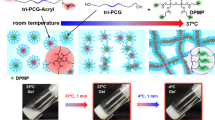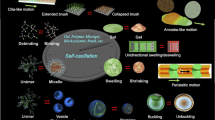Abstract
NEW controlled drug-delivery systems are being explored to overcome the disadvantages of conventional dosage forms1. For example, stimulated drug-delivery has been used to overcome the tolerance problems that occur with a constant delivery rate, to mimic the physiological pattern of hormonal concentration and to supply drugs on demand1,2. Stimuli-sensitive polymers, which are potentially useful for pulsed drug delivery, experience changes in either their structure or their chemical properties in response to changes in environmental conditions2. Environmental stimuli include temperature3,4, pH5,6, light (ultraviolet7 or visible8), electric field9–12 or certain chemicals13. Volume changes of stimuli-sensitive gel networks are particularly responsive to external stimuli, but swelling is slow to occur14,15. As well as being useful in the controlled release of drugs, such systems also provide insight into intermolecular interactions16. Here we report on a novel polymeric system, which rapidly changes from a solid state to solution in response to small electric currents, by disintegration of the solid polymer complex into two water-soluble polymers. We show that the modulated release of insulin, and by extension other macromolecules, can be achieved with this polymeric system.
This is a preview of subscription content, access via your institution
Access options
Subscribe to this journal
Receive 51 print issues and online access
$199.00 per year
only $3.90 per issue
Buy this article
- Purchase on Springer Link
- Instant access to full article PDF
Prices may be subject to local taxes which are calculated during checkout
Similar content being viewed by others
References
Langer, R. Science 249, 1527–1533 (1990).
Kost, J. (ed.) Pulsed and Self-Regulated Drug Delivery (CRC, Boca Raton, 1990).
Hoffman, A. S., Afrassiabi, A. & Dong, L. C. J. control. Release 4, 213–222 (1986).
Bae, Y. H., Okano, T., Hsu, R. & Kim, S. W. Makmmol. Chem. Rapid Commun. 8, 481–485 (1987).
Kuhn, W., Hargitay, B., Katchalsky, A. & Eisenberg, H. Nature 165, 514–516 (1950).
Siegel, R. A. & Firestone, B. A. Macromolecules 21, 3254–3259 (1988).
Ishihara, K., Hamad, N., Kato, S. & Shinohara, I. J. Polym. Sci. Polym. Chem. 22, 881–884 (1984).
Suzuki, A. & Tanaka, T. Nature 346, 345–347 (1990).
Tanaka, T., Nishio, I., Sun, S. & Ueno, S. Science 218, 467–469 (1982).
Osada, Y. & Takeuchi, Y. J. Polym. Sci. Polym. Lett. 19, 303–308 (1981).
Eisenberg, S. R. & Grodzinsky, A. J. J. Membrane Sci. 19, 173–194 (1984).
Kwon, I. C., Bae, Y. H., Okano, T., Berner, B. & Kim, S. W. Makromol. Chem., Macromol. Symp. 33, 265–277 (1990).
Ishihara, K., Muramoto, N. & Shinohara, I. J. appl. Polym. Sci. 29, 211–217 (1984).
Hirokawa, Y. & Tanaka, T. J. chem. Phys. 81, 6379–6380 (1984).
Ilmain, F., Tanaka, T. & Kokufuta, E. Nature 349, 400–401 (1991).
Tsuchida, E. & Abe, K. Adv. Polym. Sci. 45, 1–119 (1982).
Lichkus, A. M., Painter, P. C. & Coleman, M. M. Macromolecules 21, 2636–2641 (1988).
Chen, F., Pearce, E. M. & Kwei, T. K. Polymer 29, 2285–2289 (1988).
Hopfenberg, H. B. in Controlled Release Polymeric Formulations (eds Paul, D. R. & Harris, F. W.) Ch. 3 (American Chemical Society, Washington, DC, 1976).
Author information
Authors and Affiliations
Rights and permissions
About this article
Cite this article
Kwon, I., Bae, Y. & Kim, S. Electrically erodible polymer gel for controlled release of drugs. Nature 354, 291–293 (1991). https://doi.org/10.1038/354291a0
Received:
Accepted:
Issue Date:
DOI: https://doi.org/10.1038/354291a0
This article is cited by
-
Thermo-responsive release of rhodamine B in the pore-selective poly(N-isopropylacrylamide) immobilized honeycomb-patterned porous film
Polymer Bulletin (2022)
-
Thermal hysteresis of aggregation states of thermoresponsive block copolymers forming intermolecular hydrogen bonds
Polymer Journal (2021)
-
Maxwell-Wagner-Sillars Dynamics and Enhanced Radio-Frequency Elastomechanical Susceptibility in PNIPAm Hydrogel-KF-doped Barium Titanate Nanoparticle Composites
Nanoscale Research Letters (2019)
-
Main Aspects of Pharmaceutical Gel Development for Peroral Administration
Pharmaceutical Chemistry Journal (2019)
-
Preparation of isometric Liesegang patterns and application in multi-pulsed drug release system
Journal of Sol-Gel Science and Technology (2019)
Comments
By submitting a comment you agree to abide by our Terms and Community Guidelines. If you find something abusive or that does not comply with our terms or guidelines please flag it as inappropriate.



